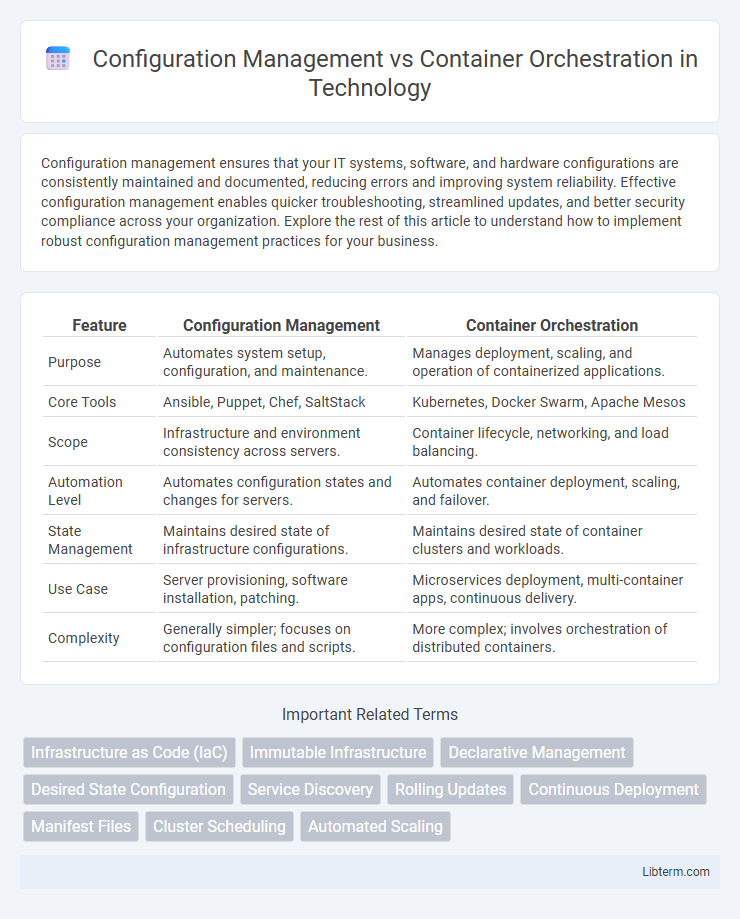Configuration management ensures that your IT systems, software, and hardware configurations are consistently maintained and documented, reducing errors and improving system reliability. Effective configuration management enables quicker troubleshooting, streamlined updates, and better security compliance across your organization. Explore the rest of this article to understand how to implement robust configuration management practices for your business.
Table of Comparison
| Feature | Configuration Management | Container Orchestration |
|---|---|---|
| Purpose | Automates system setup, configuration, and maintenance. | Manages deployment, scaling, and operation of containerized applications. |
| Core Tools | Ansible, Puppet, Chef, SaltStack | Kubernetes, Docker Swarm, Apache Mesos |
| Scope | Infrastructure and environment consistency across servers. | Container lifecycle, networking, and load balancing. |
| Automation Level | Automates configuration states and changes for servers. | Automates container deployment, scaling, and failover. |
| State Management | Maintains desired state of infrastructure configurations. | Maintains desired state of container clusters and workloads. |
| Use Case | Server provisioning, software installation, patching. | Microservices deployment, multi-container apps, continuous delivery. |
| Complexity | Generally simpler; focuses on configuration files and scripts. | More complex; involves orchestration of distributed containers. |
Introduction to Configuration Management and Container Orchestration
Configuration management automates the deployment and maintenance of software environments by managing infrastructure as code, ensuring consistency and compliance across servers and applications. Container orchestration automates the deployment, scaling, and operation of containerized applications, managing tasks like load balancing, service discovery, and resource allocation across clusters. Tools such as Ansible, Puppet, and Chef dominate configuration management, while Kubernetes and Docker Swarm lead container orchestration, each addressing distinct but complementary aspects of infrastructure automation.
Key Concepts: Configuration Management Explained
Configuration management involves maintaining and systematically handling software, hardware, and settings across an IT environment to ensure consistency, control, and compliance. It uses tools like Ansible, Puppet, and Chef to automate the deployment, configuration, and management of infrastructure, enabling version control and repeatability. This contrasts with container orchestration, which primarily focuses on automating the deployment, scaling, and management of containerized applications rather than infrastructure configuration.
Core Principles of Container Orchestration
Container orchestration centers on automating the deployment, scaling, and management of containerized applications to ensure seamless operation across diverse environments. It relies heavily on principles such as declarative configuration, which allows the system to maintain the desired state, service discovery for efficient communication between containers, and self-healing capabilities that automatically replace failed containers. These principles differentiate container orchestration from traditional configuration management, which primarily focuses on maintaining consistent software environments through scripted automation without native container lifecycle management.
Major Tools: Popular Configuration Management Solutions
Configuration management automates infrastructure provisioning and software deployment using tools like Ansible, Puppet, and Chef, ensuring consistency and compliance across servers. These solutions manage infrastructure as code, enabling version control and repeatable configurations. Unlike container orchestration platforms, configuration management focuses on managing entire system environments rather than orchestrating containerized applications.
Leading Platforms: Popular Container Orchestration Tools
Popular container orchestration tools such as Kubernetes, Docker Swarm, and Apache Mesos streamline the deployment, scaling, and management of containerized applications across distributed environments. Kubernetes, the industry leader, offers extensive features for automated rollouts, self-healing, and secret management, making it ideal for complex microservices architectures. Docker Swarm provides easier setup and tight integration with Docker containers, while Apache Mesos excels in handling diverse workloads beyond containers, enabling flexible resource sharing across clusters.
Use Cases: When to Use Configuration Management
Configuration Management is essential for managing and automating the setup, deployment, and maintenance of infrastructure with a consistent state across physical or virtual servers, making it ideal for environments where system configuration consistency and compliance are critical. It is best used when managing complex systems requiring frequent updates, patch management, and configuration drift prevention across diverse hardware and operating systems. Configuration Management tools like Ansible, Puppet, and Chef excel in scenarios demanding detailed infrastructure provisioning and long-term configuration state enforcement.
Use Cases: When to Leverage Container Orchestration
Container orchestration excels in managing dynamic, large-scale microservices environments by automating deployment, scaling, and health monitoring of containers across clusters, making it ideal for cloud-native applications requiring high availability and rapid scaling. Configuration management is best suited for maintaining consistent infrastructure states and automating software installations and updates on servers, important for stable, reproducible environments where state configuration is critical. Leverage container orchestration when dealing with complex, distributed applications needing seamless scaling, rolling updates, and fault tolerance in cloud or hybrid environments.
Comparison of Features and Functionality
Configuration management tools like Ansible and Puppet automate the provisioning, setup, and maintenance of infrastructure by managing system state through declarative scripts. Container orchestration platforms such as Kubernetes and Docker Swarm focus on deploying, scaling, and managing containerized applications with features like load balancing, service discovery, and self-healing. While configuration management emphasizes infrastructure consistency and compliance, container orchestration prioritizes dynamic application lifecycle management in distributed environments.
Challenges and Best Practices
Configuration management faces challenges such as maintaining consistency across diverse environments, managing complex dependencies, and ensuring rapid, error-free updates. Container orchestration struggles with scaling containerized applications, handling resource allocation efficiently, and ensuring high availability in dynamic environments. Best practices include using infrastructure-as-code tools like Ansible or Terraform for configuration management, and adopting Kubernetes with automated scaling and health checks to optimize container orchestration workflows.
Choosing the Right Approach for Your Infrastructure
Configuration management tools such as Ansible, Puppet, and Chef automate the setup and maintenance of servers by managing system configurations and software deployment, ensuring consistency across infrastructure. Container orchestration platforms like Kubernetes and Docker Swarm specialize in deploying, scaling, and managing containerized applications, providing dynamic resource allocation and service discovery. Selecting the right approach depends on infrastructure complexity: configuration management excels in managing traditional or hybrid environments, while container orchestration is ideal for microservices architecture and cloud-native applications.
Configuration Management Infographic

 libterm.com
libterm.com